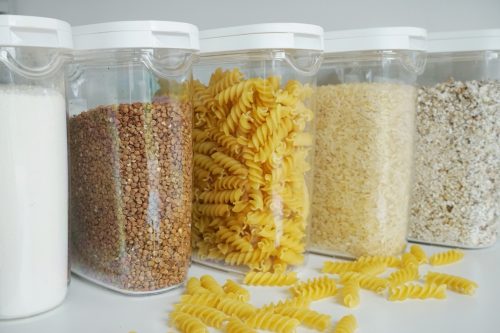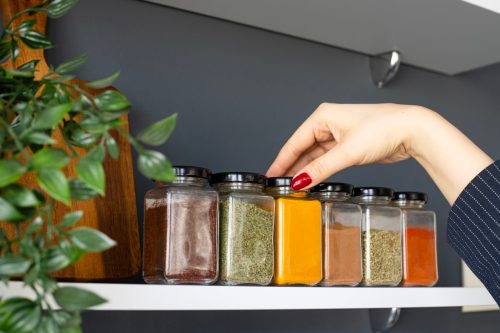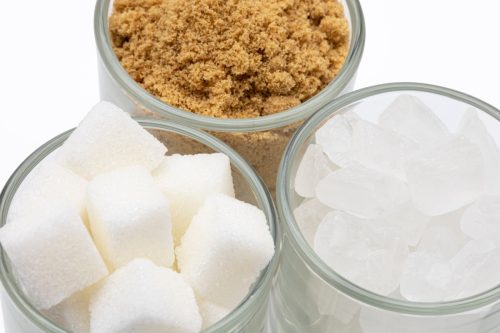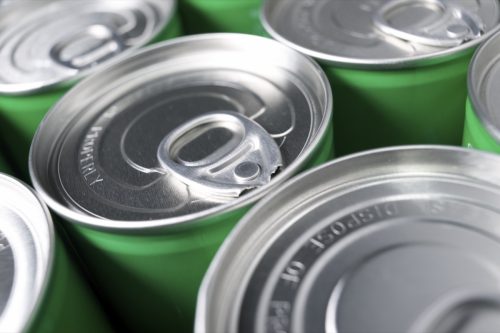36 Pantry Staples Every Home Cook Needs
Have these common ingredients stocked and ready to use.

If you're just starting out with your cooking journey, you're probably used to adding items to your grocery list as you go. With each recipe, there's always something new you need to grab, whether that's a spice, a sauce, or something you've never even heard of. But while you'll likely keep having to pick up more niche items, there are certain pantry staples that every home cook needs. We spoke with chefs and dietitians to find out what exactly you should have on your shelves—and why.
"If you have staples at home, you can cook a delicious, fast meal any time, any day," Kat Lieu, founder of Subtle Asian Baking and author of Modern Asian Kitchen, tells Best Life. "With a stocked pantry, you can always be creative in the kitchen and try new recipes on the fly. Meal prepping also becomes a breeze."
Even better, a well-kept pantry can relieve some stress in the kitchen, says Julie Evink, food blogger and author of Julie's Eats & Treats Cookbook.
"With a variety of staples on hand, it's easy to have a few go-to meals you know are always on hand when life gets busy. This always helps if you have unexpected guests," Evink shares.
Wondering what you should stock up on? Read on for 36 must-haves.
RELATED: 11 Essential Kitchen Items to Always Have for Entertaining.
Pantry Staples Every Home Cook Needs
Dry Goods

- Breadcrumbs: You'll be happy you have breadcrumbs on hand whenever you make meatballs or need a crispy casserole topping. Consider keeping panko breadcrumbs in your pantry as well, as those absorb less oil and get you a crunchier taste.
- Nuts: Nuts are a great shelf staple—perfect for adding to salads or reaching for when you need a healthy snack. Stock up on peanuts, walnuts, almonds, and pecans. Victoria Smith, RDN, CDN, CEDS, founder of Nourished With Love NJ, notes that nuts "can spruce up dishes like oatmeal" and used to make homemade nut butter.
- Seeds: Different kinds of seeds are also reliable staples, Smith says. She recommends picking up both chia and sesame seeds.
- Rice: Even if you aren't making something that directly calls for rice, it's a reliable option when you need a starchy side or something to add to a soup. You can have a white or brown variety on hand, and Lieu also suggests sticky rice. (The latter is helpful if you like Asian-style desserts and dishes!)
- Pasta: Noodles of any kind are also perfect to have for a last-minute meal or to supplement a meal. Grab the varieties you like (spaghetti, penne, etc.), as pasta dishes can be somewhat flexible when it comes to noodle shape and size. If you have kids at home, Evink says pasta is a good go-to meal, especially if you grab some "fun noodle shapes."
RELATED: Ina Garten's 7 Favorite Kitchen Items That Are Surprisingly Affordable.
Oils and Vinegars

- Extra virgin olive oil: This is the cooking oil you may reach for the most. According to Smith, it's a "starting points for stove-top cooking, a foundation for homemade salad dressings, and that 'final touch' for meals." Pro tip: Smith recommends having one bottle of EVOO for cooking and one unfused with an herb like rosemary—perfect for drizzling.
- Avocado oil: This particular type of oil is useful when you're cooking at higher temperatures, as it has a higher smoke point than extra virgin olive oil. Lieu recommends avocado oil for dishes like stir fry!
- Sesame oil: This kind of oil is used in Asian and Middle Eastern dishes, offering a nutty taste and smell.
- Neutral oils: Lieu cites the importance of neutral oils, which "don't impart added flavor to the dishes you cook." These include vegetable, corn, and canola oils.
- Apple cider vinegar: Not only is ACV great for your gut health, but it's also a helpful ingredient when you need something sweet and tangy.
- Red wine vinegar: Red wine vinegar is another one of Smith's staples, delicious when mixed with olive oil for a vinaigrette or when making a marinade.
- White wine vinegar: Like its red wine counterpart, white wine vinegar is also used in cooking, dressing, marinades, as well as pickling.
- Champagne vinegar: This vinegar variety is milder and more floral than its counterparts, made from Chardonnay and Pinot Noir grapes. It's great as a light addition to a salad dressing or when added to a sauce.
- Rice vinegar: A staple in dishes originating from Asia, rice vinegar is something you should keep on hand if you enjoy making stir fries or other Asian-inspired sauces and marinades.
RELATED: 9 Best Brand-Name Items to Buy Generic, Retail Experts Say.
Herbs and Spices

- Salt: This one probably goes without saying, but it's what you'll need with pretty much every recipe—including for baking. You may want to stock different varieties, including table salt, kosher salt, flaky sea salt, and mineral-rich fine pink Himalayan salt.
- Black pepper: Evink calls salt and its partner, pepper, "the two most essential spices for food seasoning." Pick pepper up pre-ground or in peppercorn form and grind it yourself.
- Dried herbs: While fresh herbs are great when you can get to the grocery store, many recipes will also call for the dried variety. Italian seasoning, oregano, basil, and thyme can "add flavor to pasta dishes, roasted vegetables, soups, stews, and more," Evink says.
- Ground spices: When building up your spice rack, you should fill it with common—and delicious—additions such as cayenne, chili powder, cinnamon, cumin, nutmeg, and paprika.
- Garlic and onion powder: If you're going to invest in two spices to start, make it garlic and onion powder. According to Evink, they are "easy substitutes" for the fresh varieties and "add depth of flavor to many dishes."
Baking Ingredients

- Flour: The all-purpose variety is a good go-to for baking and useful when you need to thicken sauces, Evink says. Depending on your dietary needs, consider keeping whole wheat, gluten-free, rye, or almond flour in the pantry as well.
- Sugar: The typical granulated (white) sugar will be an ingredient in countless recipes and can be used to sweeten beverages and make sauces, Evink says. Keep light and brown sugar on hand as well if you plan to be baking often.
- Baking soda: Made of 100 percent sodium bicarbonate, baking soda creates carbon dioxide gas when mixed with an acidic ingredient like honey, brown sugar, or buttermilk. (As a bonus, it's helpful to have on hand for cleaning purposes!)
- Baking powder: Baking powder is a leavening agent and is not to be confused with baking soda. This one is a mix of baking soda, acidic salts, and starch that absorb moisture when baking. Your recipe will specify whether you should use baking soda or powder, so just make sure to double-check the labels when pulling them from your pantry.
- Vanilla extract: This baking staple isn't added in large amounts, but it packs a punch in any recipe by enhancing the flavor and aroma.
- Chocolate chips or chunks: Keep these on hand for when you're whipping up a batch of cookies or banana bread. Consider grabbing different varieties—milk, dark, semisweet—so you have choices when baking.
RELATED: 13 Worst Items to Store in Your Pantry.
Canned Goods

- Beans: Beans a great source of protein in soups, chilis, and with tacos—and they can be served hot or cold, Smith points out. Consider stocking up on some common beans like pinto, cannellini, chickpeas, black, lima, pinto, and kidney. (Beans are also good to have if you have vegetarian family members or friends you'll be cooking for!)
- Tomatoes: Canned tomatoes are helpful to have for different recipes, packed in their juices in order to preserve flavor. Grab a can of whole peeled tomatoes, San Marzano, crushed, and diced tomatoes, as well as tomato paste. Also pick up tomato sauce as an easy option for pasta.
- Canned corn: You don't have to wait until the height of summer to enjoy corn. The canned variety will keep in the pantry and "can add fiber and texture to an omelet, a quesadilla, and a crockpot chili," Smith notes.
- Broths and stocks: Chicken and vegetable broths and stocks are a must, too. You can buy them canned or boxed—and you'll reach for them whenever you need to add flavor to soups, stews, and sauces, Evink says.
Sauces and Condiments

- Mayonnaise: A staple on sandwiches, mayo is also used in marinades and sauces. Consider going with a variety made with avocado oil for an option with healthier fats.
- Soy sauce: This is great to have on hand when you order sushi takeout, but it's also a common addition to stir fries, marinades, and glazes. You can opt for low-sodium varieties, and Lieu recommends having both light and dark varieties in your pantry. Both will be helpful in adding that elusive umami taste to your dishes—and even to baked goods like cookies and brownies, she says.
- Peanut butter: This nut butter is more versatile thank you think. Evink highlights peanut butter as a "protein-rich spread for sandwiches, snacks, or adding to sauces."
- Honey: Pick up your favorite brand from the grocery store or a local variety to use as a sweetener in your tea, sauces, and while baking.
- Mustard: Catherine McCord, entrepreneur and cookbook author, points to mustard as a pantry staple, and it will stay fresh when it's unopened. Different kinds of mustard are useful, including standard yellow mustard, Dijon, honey, and whole grain. Not only are they tasty on a sandwich, but you'll soon realize how many savory sauces call for mustard as an ingredient!
- Worcestershire sauce: Believe it or not, Worcestershire sauce is a necessary staple for marinades, meat dishes, soups, and even drinks to enhance flavor.
- Maple syrup: This is another staple on Smith's list. While you certainly need it for pancakes and waffles, maple syrup can also be used as a sweetener when baking or cooking.
RELATED: 11 Best Kitchen Items to Buy From Target.
How often should pantry items be replaced?

According to the U.S. Department of Agriculture, your pantry goods will likely last more than you even expect.
"Most shelf-stable foods are safe indefinitely," the agency states. "In fact, canned goods will last for years, as long as the can itself is in good condition (no rust, dents, or swelling). Packaged foods (cereal, pasta, cookies) will be safe past the 'best by' date, although they may eventually become stale or develop an off flavor."
For reference, the agency's Shelf-Stable Food Safety fact sheet says that low-acid canned goods like soups and stews can last two to five years on the shelf, while rice and dried pasta can last two years.
You should be able to tell if your food has lost quality when you open it, but be mindful that some of the dates on food might be referring to quality as opposed to safety. The U.S. Food and Drug Administration (FDA) notes that the food manufacturer indicates quality could decrease by the "use by" date.
Regularly check your cans for damage, which could be indicated by swelling, leakage, punctures, holds, fractures, extensive rusting, or crushing or denting that leave you unable to open your cans with a manual can opener. If you're not sure about the quality of something in your pantry, throw it out.





















